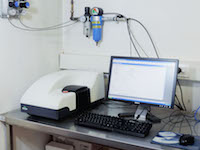Members Login

Channels
Special Offers & Promotions
Malvern Zetasizer Nano Supports Advances in Carbon Nanotube Synthesis
New research from the University of Padova in Italy shows how the Zetasizer Nano S, a nanomaterial and molecular characterization system from Malvern Instruments, is supporting the development of soluble carbon nanotubes (CNTs).
 CNTs exhibit unique electronic, optical, mechanical and structural properties and are emerging as potentially important for a number of industrial applications including organic photovoltaic cells. One of the benefits of using soluble CNTs is that they are amenable to solution-based, low-cost, commercial manufacturing methods. The Zetasizer Nano is proving to be an easy-to-use tool for tracking and optimizing the functionalization reactions used to induce solubility.
CNTs exhibit unique electronic, optical, mechanical and structural properties and are emerging as potentially important for a number of industrial applications including organic photovoltaic cells. One of the benefits of using soluble CNTs is that they are amenable to solution-based, low-cost, commercial manufacturing methods. The Zetasizer Nano is proving to be an easy-to-use tool for tracking and optimizing the functionalization reactions used to induce solubility.
For full details of the study please refer to the recently published paper “Chemistry of Carbon Nanotubes in Flow”
The focus of research at the university is the development of optimized continuous flow reaction systems for CNT functionalization. This approach has the potential to enable functionalized CNT manufacture with shorter reaction times and under relatively benign conditions, low temperature and pressure, thereby reducing the cost of production. A range of analytical methods is used to assess the extent and result of functionalization, under different reaction conditions.
Measurements of hydrodynamic diameter, made using the Zetasizer Nano S, have proved especially helpful because the hydrodynamic diameter of the functionalized CNTs has been shown to correlate directly with the extent of CNT functionalization and solubility. Measurements of hydrodynamic diameter therefore provide an indication of the success or otherwise of the reaction. As a result they are a fast and efficient way of tracking the functionalization reactions being studied, supporting the development of optimized reaction conditions.
The Zetasizer Nano S is a dynamic light scattering system for the measurement of particle size in dispersions, across the range 0.3 nm to 10 µm. It also provides molecular size and molecular weight measurements.
Media Partners


